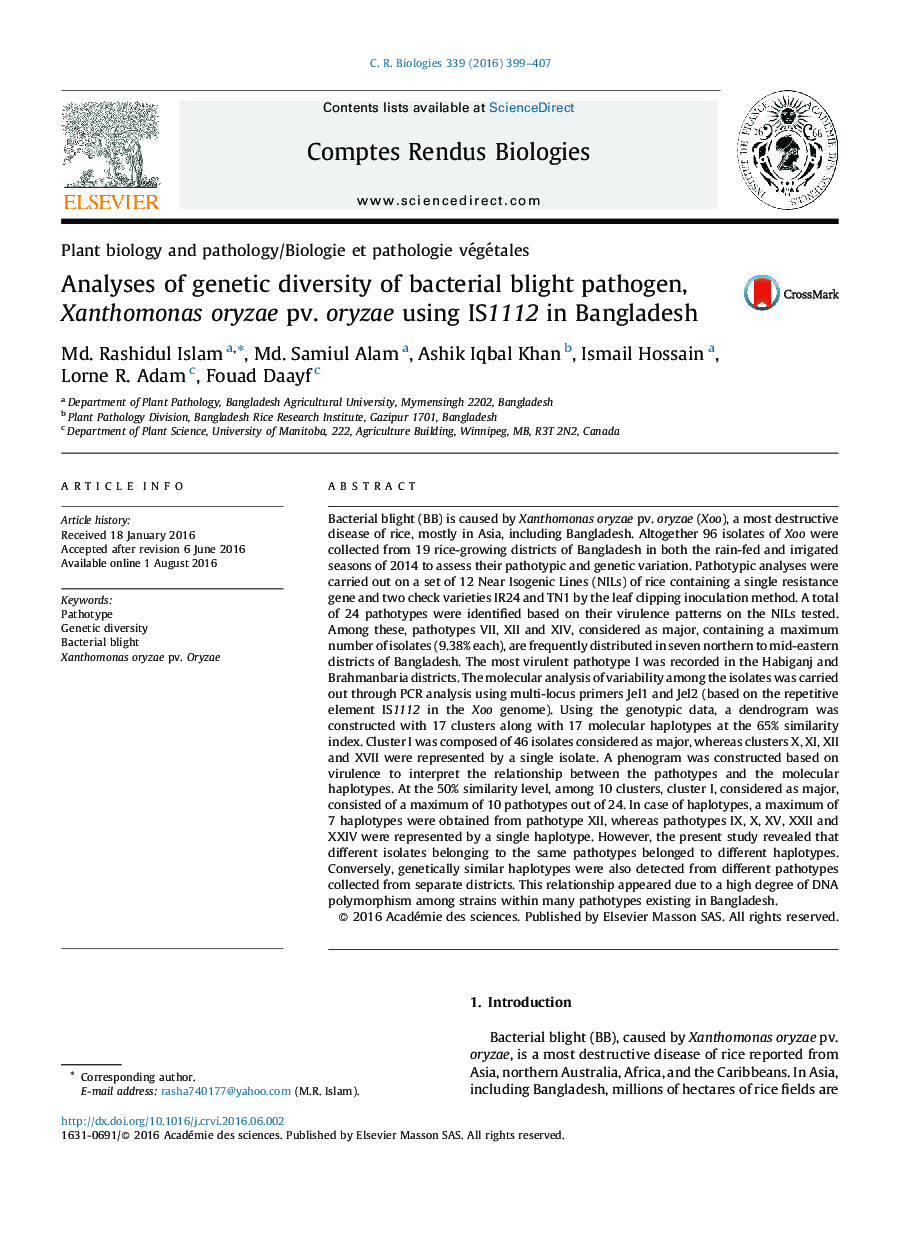| کد مقاله | کد نشریه | سال انتشار | مقاله انگلیسی | نسخه تمام متن |
|---|---|---|---|---|
| 5585490 | 1568206 | 2016 | 9 صفحه PDF | دانلود رایگان |
عنوان انگلیسی مقاله ISI
Analyses of genetic diversity of bacterial blight pathogen, Xanthomonas oryzae pv. oryzae using IS1112 in Bangladesh
دانلود مقاله + سفارش ترجمه
دانلود مقاله ISI انگلیسی
رایگان برای ایرانیان
کلمات کلیدی
موضوعات مرتبط
علوم زیستی و بیوفناوری
علوم کشاورزی و بیولوژیک
علوم کشاورزی و بیولوژیک (عمومی)
پیش نمایش صفحه اول مقاله

چکیده انگلیسی
Bacterial blight (BB) is caused by Xanthomonas oryzae pv. oryzae (Xoo), a most destructive disease of rice, mostly in Asia, including Bangladesh. Altogether 96 isolates of Xoo were collected from 19 rice-growing districts of Bangladesh in both the rain-fed and irrigated seasons of 2014 to assess their pathotypic and genetic variation. Pathotypic analyses were carried out on a set of 12 Near Isogenic Lines (NILs) of rice containing a single resistance gene and two check varieties IR24 and TN1 by the leaf clipping inoculation method. A total of 24 pathotypes were identified based on their virulence patterns on the NILs tested. Among these, pathotypes VII, XII and XIV, considered as major, containing a maximum number of isolates (9.38% each), are frequently distributed in seven northern to mid-eastern districts of Bangladesh. The most virulent pathotype I was recorded in the Habiganj and Brahmanbaria districts. The molecular analysis of variability among the isolates was carried out through PCR analysis using multi-locus primers Jel1 and Jel2 (based on the repetitive element IS1112 in the Xoo genome). Using the genotypic data, a dendrogram was constructed with 17 clusters along with 17 molecular haplotypes at the 65% similarity index. Cluster I was composed of 46 isolates considered as major, whereas clusters X, XI, XII and XVII were represented by a single isolate. A phenogram was constructed based on virulence to interpret the relationship between the pathotypes and the molecular haplotypes. At the 50% similarity level, among 10 clusters, cluster I, considered as major, consisted of a maximum of 10 pathotypes out of 24. In case of haplotypes, a maximum of 7 haplotypes were obtained from pathotype XII, whereas pathotypes IX, X, XV, XXII and XXIV were represented by a single haplotype. However, the present study revealed that different isolates belonging to the same pathotypes belonged to different haplotypes. Conversely, genetically similar haplotypes were also detected from different pathotypes collected from separate districts. This relationship appeared due to a high degree of DNA polymorphism among strains within many pathotypes existing in Bangladesh.
ناشر
Database: Elsevier - ScienceDirect (ساینس دایرکت)
Journal: Comptes Rendus Biologies - Volume 339, Issues 9â10, SeptemberâOctober 2016, Pages 399-407
Journal: Comptes Rendus Biologies - Volume 339, Issues 9â10, SeptemberâOctober 2016, Pages 399-407
نویسندگان
Md. Rashidul Islam, Md. Samiul Alam, Ashik Iqbal Khan, Ismail Hossain, Lorne R. Adam, Fouad Daayf,